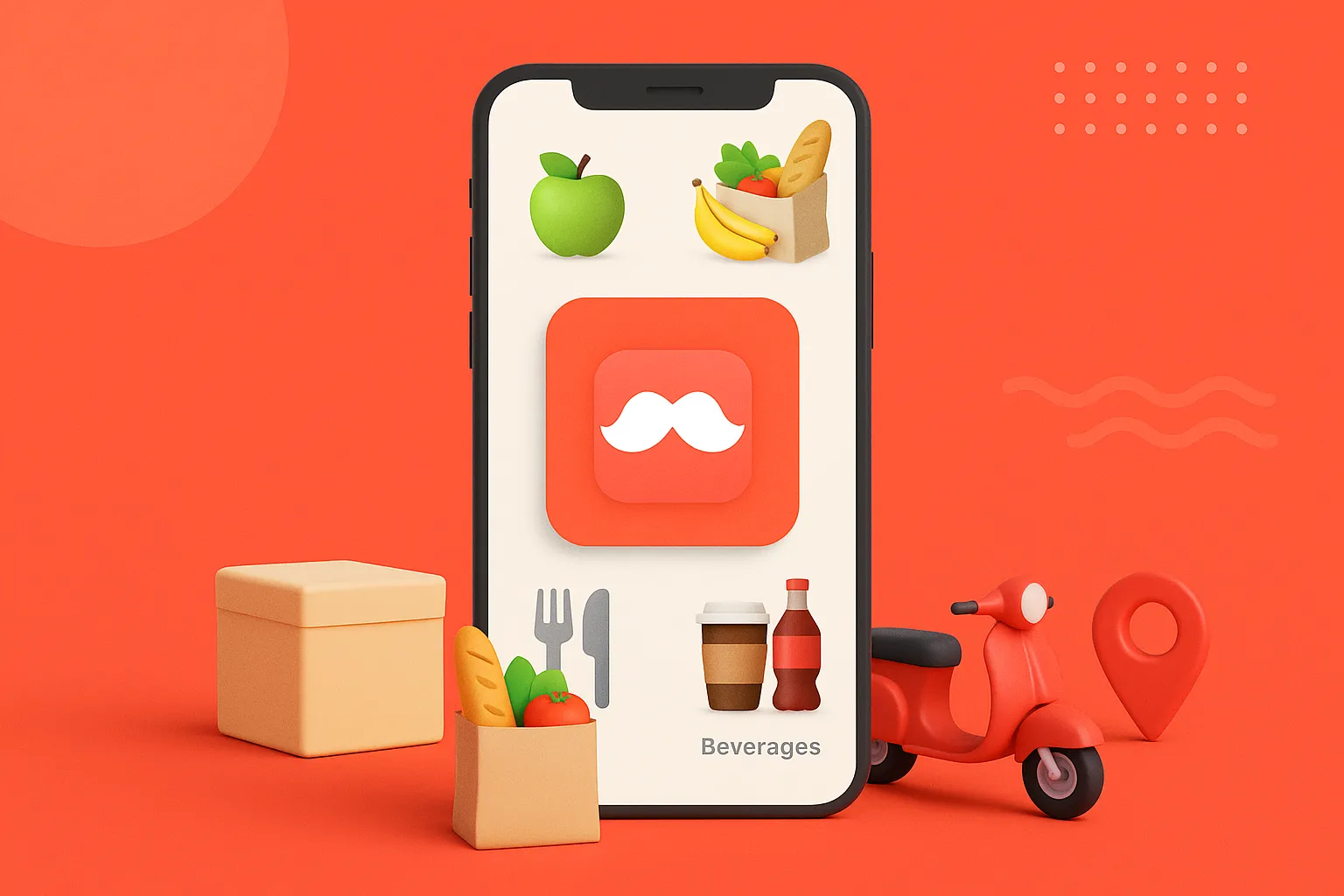Business model of Rappi has redefined convenience for millions across Latin America. What began as an on-demand delivery app quickly transformed into a full-fledged super app, offering everything from groceries and restaurant orders to fintech services.
Its business model of Rappi worth studying because it shows how combining multiple verticals under one platform can fuel rapid growth, boost user engagement, and open up diversified revenue streams. If you’re considering launching an on-demand marketplace or a super app, Rappi
approach offers valuable lessons in scale, retention, and monetization.
What is Rappi & How It Works
Rappi is a Colombian-born super app that solves the problem of fragmented, time-consuming errands. Instead of juggling multiple apps for food, groceries, pharmacy items, or even cash delivery, users can handle everything in one place.
The Problem It Solves
Before Rappi, getting essentials often meant making separate trips or dealing with different delivery platforms. This was inconvenient, slow, and costly. centralizes these services into a single ecosystem, saving users time and offering unmatched convenience.
Who Uses It
- Busy professionals who want quick deliveries
- Families ordering groceries and household essentials
- Small business owners relying on on-demand couriers
- Consumers using Rappi Pay for digital payments and credit
How Its work Operates
Rappi connects three main groups seamlessly via its platform:
- Customers browse products, place orders, and track deliveries through the app interface.
- Partners (restaurants, grocery stores, pharmacies) list their inventory and receive incoming orders.
- Couriers (known as “Rappitenderos”) pick up and deliver items to the customer’s doorstep.
The company earns revenue through commissions on transactions, delivery fees, paid subscriptions, advertising placements, and financial products. Over time, has evolved beyond delivery to position itself as a comprehensive lifestyle and financial services platform.
Read More : What is Rappi App and How Does It Work?
Target Audience and Customer Segments
Rappi’s business model thrives because it serves multiple high-value customer segments, each fueling different parts of the ecosystem:
- Urban Professionals
People with busy schedules who prefer convenience over price. They frequently order meals, groceries, and pharmacy items to save time. - Families & Households
Users managing household shopping, last-minute needs, and large weekly orders delivered right to their door. - Small and Medium Businesses
Local stores, restaurants, and pharmacies that partner with to expand their reach and grow revenue. - Young Adults & Students
Heavy users who rely on for late-night snacks, quick meals, and micro-mobility services. - Financial Service Users
Consumers adopting RappiPay for digital wallets, credit lines, bill payment, and peer-to-peer transfers.
This broad, multi-layered audience supports ambition to be the “everything app,” combining logistics, commerce, and financial services in one platform.
Features That Support the Business Model
Rappi’s success hinges on an ecosystem of features that drive orders, engagement, and monetization. Here are the core features fueling its business model:
Multi-Category Ordering
Users can order food, groceries, pharmacy items, and even request cash delivery—all from a single app interface. This all-in-one convenience keeps people coming back for more.
Rappi Prime Subscription
Prime is a paid membership that offers free deliveries, exclusive discounts, and faster service. Subscriptions generate recurring revenue while boosting customer loyalty.
RappiPay
The built-in digital wallet enables seamless payments, peer-to-peer transfers, and access to credit products. Pay locks users into the ecosystem and adds valuable financial revenue streams.
Live Tracking & Notifications
Real-time order tracking and instant notifications keep customers informed at every step. This transparency improves satisfaction and reduces the burden on support teams.
In-App Advertising
Merchants and brands can pay for sponsored listings and featured placements inside the app. These ads are a high-margin revenue source that grows with the marketplace.
Express Delivery & Scheduled Orders
Rappi offers ultra-fast delivery in under 30 minutes as well as scheduled orders to match customer preferences. Both options help increase order frequency and differentiate the service.
Cash Withdrawal Service
One of Rappi’s unique features allows users to request cash delivered to their door by a courier. This adds extra utility that keeps users engaged and loyal.
Together, these features create convenience, stickiness, and a diversified revenue base that sets apart from traditional delivery apps.
Read More : Best Rappi Clone Scripts in 2025: Features & Pricing Compared
Revenue Streams of Rappi
monetization strategy is designed to diversify income across delivery, subscriptions, advertising, and fintech. Here’s a clear breakdown:
| Revenue Stream | How It Works |
| Delivery Fees | Customers pay per order, with dynamic pricing based on distance and urgency. |
| Commission on Orders | Restaurants, grocery stores, and merchants pay a commission on each sale. |
| Prime Subscriptions | Monthly or annual fees for free deliveries and premium perks. |
| In-App Advertising | Merchants and brands pay for promoted placement and sponsored listings. |
| RappiPay Services | Revenue from digital wallet transactions, credit products, and fees. |
| Service Fees & Surcharges | Extra fees for express delivery, heavy items, or peak-hour orders. |
Key Highlights:
- Delivery Fees:
Core revenue from customer payments per transaction. - Merchant Commissions:
Often 15–30% of order value, similar to food delivery platforms. - Prime Membership:
Drives predictable monthly recurring revenue. - Advertising:
A high-margin stream that scales as the merchant base grows. - Fintech:
RappiPay adds revenue from payment processing and lending. - Service Fees:
- Incremental income from added convenience options.
Read more : Revenue Model of Rappi: How Latin America’s Super App Makes Money
Key Cost Structure of Rappi
Running a super app like Rappi requires significant investment across multiple operational areas. Here are the main expenses:
- Courier Payments
The largest cost bucket. pays delivery partners per trip, often with incentives during peak hours. - Technology & Development
Maintaining and upgrading the platform, app infrastructure, and payment systems. - Customer Support
24/7 support operations to handle order issues, refunds, and account inquiries. - Marketing & User Acquisition
Promotions, referral bonuses, and advertising to attract new users and retain existing ones. - Merchant Onboarding & Account Management
Costs related to signing up restaurants, stores, and service providers. - Financial Services Operations
Compliance, credit risk management, and operational expenses tied to Pay. - Logistics & Warehousing
In some markets, operates dark stores or micro-fulfillment centers for faster delivery.
Understanding this cost structure is critical for founders considering a similar platform, as profitability depends on optimizing logistics and achieving high order volume.
Latest Rappi Updates and Strategies
Rappi continues to evolve its business model to stay ahead of competitors and deepen customer loyalty. Here are some of the latest updates shaping its trajectory:
- RappiCard Expansion
The Card credit card has expanded to more countries in Latin America, driving fintech adoption and new revenue from credit fees and interest. - Ultra-Fast Grocery Delivery
Rappi has invested heavily in micro-fulfillment centers and dark stores, enabling 10–15 minute delivery in major cities. - Dynamic Pricing Enhancements
AI-powered pricing algorithms now adjust fees in real-time based on demand, distance, and courier availability. - New Subscription Tiers
Prime has introduced tiered plans with varying benefits to target different spending levels and increase membership conversions. - Integrated Health Services
Partnerships with pharmacy chains and telemedicine providers have added prescription delivery and virtual consultations. - Sustainability Initiatives
piloting eco-friendly packaging and electric delivery vehicles in select markets to reduce environmental impact. - Expanded RappiPay Wallet Features
Additional capabilities, like bill payment and investment options, are being rolled out to lock users into the ecosystem.
These innovations reinforce super app positioning and help grow customer lifetime value.
Read more : What is the marketing strategy of Rappi?
Takeaways for Startup Founders
If you’re planning to build an on-demand delivery or super app, there are a few clear lessons from business model:
- Diversify Early
Rappi scaled faster because it didn’t limit itself to food delivery. Groceries, pharmacies, and fintech services broadened its user base and revenue streams. - Invest in Loyalty Programs
Subscription models like Prime generate recurring revenue and improve retention. Even small perks can create strong habits. - Prioritize Convenience and Speed
Ultra-fast delivery and cash withdrawal services turned into a daily utility rather than a once-in-a-while app. - Think Beyond Transactions
Financial products like RappiPay and Card deepen customer relationships and differentiate the brand. - Own the Customer Experience
Real-time tracking, excellent support, and reliable logistics are non-negotiable for high-volume platforms.
If you’re inspired to build a similar platform, Miracuves can help you get there faster. We specialize in ready-made app clones and custom solutions that cover every aspect—ordering workflows, courier management, subscriptions, payments, and more.
Explore our Uber Clone or Delivery App Solutions to see how you can launch a robust, scalable business without starting from scratch.
Read more : Reasons startup choose our Rappi clone over custom development
Conclusion :
Rappi’s business model shows what’s possible when you combine multiple services under one seamless platform. From delivery and subscriptions to fintech and advertising, every piece adds value and drives revenue.
If you’re considering building an on-demand app or a super app inspired by there’s never been a better time. The demand for convenience is only growing, and users expect fast, reliable, and diverse services in a single place.
Miracuves can help you bring this vision to life with proven app clone solutions and custom development tailored to your market. Whether you want a ready-made delivery app or an end-to-end super app ecosystem, our team will guide you every step of the way.
Ready to launch your Rappi-style platform? Contact Miracuves today to get started.
FAQs :
1. How does Rappi make money?
Rappi generates revenue through multiple channels: delivery fees, commissions from merchants, Prime subscriptions, in-app advertising, and financial products via Pay and Card. This diversified approach keeps income steady and reduces reliance on any single stream.
2. What makes Rappi different from other delivery apps?
Rappi positions itself as a super app. Unlike single-category delivery platforms, it offers groceries, meals, pharmacy items, cash delivery, and financial services in one place. This convenience creates higher engagement and loyalty.
3. How does Rappi keep couriers engaged?
Couriers earn per delivery, with extra incentives during high-demand times. also provides transparent earnings tracking, bonuses, and flexible working hours to keep its logistics workforce motivated.
4. Is Rappi profitable?
Like many large-scale delivery startups, Rappi has invested heavily in growth and market share. While profitability is improving with the expansion of fintech services and subscriptions, margins remain thin in core delivery categories due to operational costs.
5. Can I build a similar app with Miracuves?
Absolutely. Miracuves offers ready-made delivery app clones and fully customized super app solutions. From courier management to payment integration, our team provides everything you need to launch quickly and scale confidently. Explore our solutions to learn more.
Related Article :








